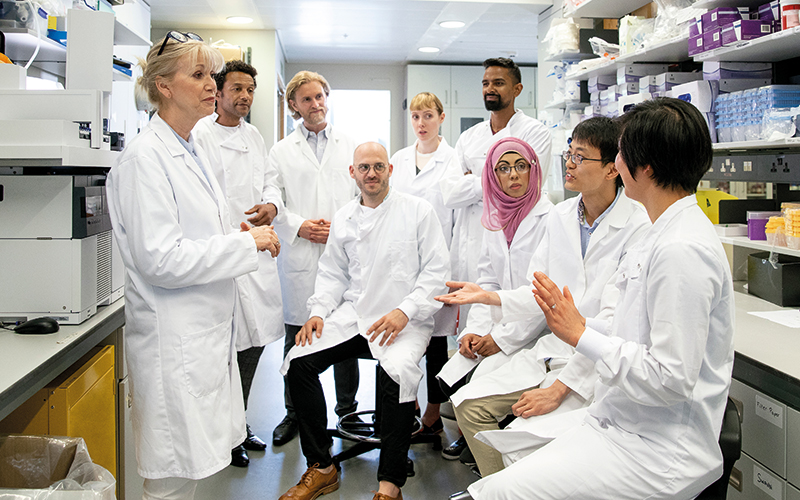Phil Cummings, an Advanced Biomedical Scientist and Training Manager, navigates the complex worlds of leadership and management.

Leadership and management theories attempt to explain some of the most complex workplace dynamics. When we read “management”, we imagine an executive silhouette creating rules for the workforce with the aim of increasing productivity and corporate value. Management, therefore, is a unilateral process that directs achievement of objectives through the efficient use of resources. However, when we imagine a leader, our perspectives begin to diverge and become much more creative. A leader is someone, an individual or a group, held in high regard and for reasons that are mutually beneficial. A quick Google, and activists such as Mahatma Gandhi and Martin Luther King Jr can be found. These are rare examples of leadership in action. Look closer to home: parents, siblings, carers, and volunteers all display various aspects of leadership.
It is a multi-dimensional phenomenon, focusing on motivation and inspiration, as opposed to organisation and delegation. Leaders can be thought of as the catalyst of organisational and social change. If we combine both concepts, we conclude that an organisation may only achieve true operational effectiveness when leaders and managers work together to achieve the same outcome.

Organisational culture
An additional concept is that of organisational culture. A phenomenon steeped in psychological and social theory that can be simply defined as “the way we do things here”. It is the day-to-day working environment. We spend so much of our time in work that we settle into our own comfort zones. When an organisation undergoes a period of change, this cultural paradigm begins to shift. The change could be the successful recruitment of a new biomedical support worker, the promotion of a laboratory scientist or introducing a new process. It is fair to say that the cultural movement may be positive, negative or both, depending on the observer. The magnitude of cultural disruption also depends on the nature of the internal or external drivers influencing the need for change. If we look at the Lord Carter of Coles reports over the past 10 years, this aspect becomes quite clear – the shift to amalgamate regional laboratories into “hub-and-spoke” models is beyond the scope of this writing, but will instil a sense of insecurity about the future of laboratory services. Another factor to consider is the amount of resistance to change. This could range from informal workplace protests to union-based industrial action. The image projected here is often found through management instigation of an unfavourable change with the opposing leaders conferring resistance, but this isn’t always the case. Those who support, promote, or instigate organisational change are referred to as “agents of change”. Often, these are not managerial executive-types, but any individual that can demonstrate a very specific set of characteristics. They must be able to integrate, innovate, grow and continuously develop. They also need to be able to quickly generate relationships and impart credibility. I believe that these attributes impart fluidity to the agents, enabling them to transcend existing cultural challenges while generating good working relationships within the organisational hierarchy. These are prime examples of effective leadership and ones that we should look to empower within our workforce.
Optimising performance
When it comes to optimising organisational performance, there is vast empirical evidence to support strong collaborative cultures being the key differentiator between success and failure. When the right style of leadership is present, these cultures convey greater stakeholder value. This means when people work together, we get a much better result. If we consider the characteristics of a change agent as desirable for an organisation to successfully adapt to change, then we need to identify and empower these individuals. This can be accomplished by developing a “learning organisation”, a concept coined by Peter Senge in 1990. Here, employees are encouraged to expand their capacity to innovate by being free to discuss concerns in a safe and open environment. This translates to staff providing solutions to problems and feeling able to action them. They should be empowered by management to instigate changes. Compare this to the above description of change agents, who require the freedom, autonomy, and accountability to generate the momentum required to facilitate change. We then arrive at an organisation that is capable of improvement strategies that are self-perpetuating. What we need to develop are cultures based on education and development, with supportive and collaborative leadership, and an environment free of reprisal. To achieve this, we must accept that learning and teaching are an integral component of normal working practices and should not be treated as an entirely separate entity. For management, this will mean putting aside time and resources for team building and work-based learning. By doing this we remove barriers and open avenues for natural development to take place. This should be extended across educational and professional boundaries to facilitate shared learning and better provide the means for cross-discipline support.

“Agents of change must be able to integrate, innovate, grow and continuously develop”
Sustainable workplace culture
We are all, at one time, followers and it takes a good follower to be a great leader. My aim is to highlight the importance of creating a sustainable workplace culture, with education and development at its core. Knowledge should be appreciated as a key strategic resource and management need to recognise the role and value of our learners. When this happens we can use it to better inform laboratory processes and provide a much better service to our users. A leader who acknowledges the work of employees and acts on their suggestions is pivotal to enabling successful collaboration. By doing this we can increase workforce resilience through times of uncertainty. Everyone within the organisation is a potential change agent, capable of directing us to the next best thing. If only we knew how to provide the right opportunities. Making the most of our clinical colleagues is a good start and, so far, I’ve never known a clinical setting to say “no ” to shared learning experiences. From my point of view it seems we are the only ones missing out.
Phil Cummings is an Advanced Biomedical Scientist and Training Manager at Leeds Teaching Hospitals NHS Trust.
Image credit | iStock
